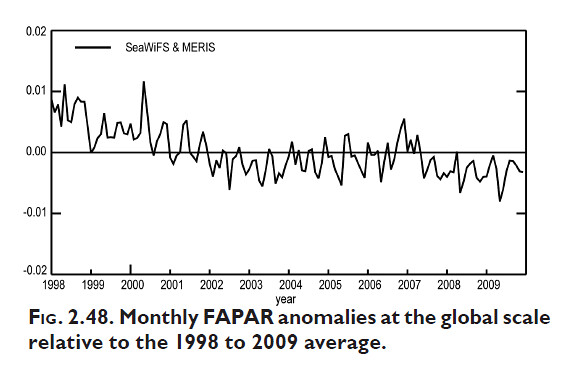CO2 is plant food. I know this is true, because smart Republicans likeReps. Dan ShimkusandMichele Bachmannsaid so. In fact, the "CO2 is plant food" meme can bring up 48,000 hits on Google.
So rising CO2 should be good for plants, right? Because a conservative argument with a patina of science just can't be wrong.
Just a couple of little flies in the ointment:land plants are dyingas CO2 rises. Andoceanic plants are dyingas CO2 rises, too.
Earth's plant life is being killed by the heat.
This week's edition of the journalSciencecontainsa paperby Maosheng Zhao and Steven W. Running concerning the reaction of land plants to climate change. Zhao and Running have been measuring terrestrial net primary production (NPP), which is a measure of how much carbon land plants take in and store as part of their structures. While earlier measures looked good (NPP rose in the '90s), over the past decade the picture is grim: as CO2 has been rising, NPP has been falling in lockstep. Plants are not keeping up with human CO2 production. Which means that the ability of land plants to act as a carbon sink in actually weakening as time goes on.
NPP is tricky to measure though it takes a complex model with a lot of inputs. But there is another way to measure the growth (or decline) of land plants, and that is by satellite measurement. NOAA's annualState of the Climatereport is a must-read for anyone interested in the guts of climate science today.
One of the most depressing facts in this report is an indicator called the Fraction of Absorbed Photosynthetically Active Radiation, or FAPAR. Photosynthesis uses only very narrow parts of the spectrum, so you can look down at the earth and see how much of those frequencies are being absorbed on the Earth. Essentially, FAPAR is a measure of how much photosynthesis is going on -- or how much plants are growing. From space, FAPAR can be measured over land areas quite easily, and has been measured since 1998. And the picture isn't good.
We've lost about 1.5% of global land-plant growth over the past 12 years. Interestingly, this loss is concentrated in the southern hemisphere, as seen in this graphic:
Although plant growth has declined in the Northern temperate zone and in the tropics, the Southern temperate zone has seen the steepest declines. This is because climate-change driven drought has hit the Southern hemisphere the hardest. If conditions in Russia are any indication, however, the Northern Hemisphere won't be far behind.
*******
Three weeks ago inNature, the world's oldest scientific journal (and one of the most respected), Daniel G. Boyce, Marlon R. Lewis & Boris Worm report ona studythey undertook to determine global phytoplankton concentration over the 20th century.
Phytoplankton are tiny single-celled marine plants that form the base of the ocean's food chain. Everything that swims in the sea depends on phytoplankton either directly or indirectly as a food source. More important, phytoplankton are responsible for about half of the photosynthesis (read: oxygen) on earth.
But phytoplankton are difficult to study, because the level of phyoplankton in the sea varies radically, by several orders of magnitude (that's by thousands of times), and those variations are seasonal, and regional, and there's a bunch of random noise too. So you need a lot of data over a long time period to make sense of what's going on in the long term. And Boyce et. al. have finally got the data.
Boyce's shocking result: since 1899, phytoplankton has shown a long-term decline of about 40%, especially during the most recent years. The authors found declines in 8 of 10 ocean basins, and the declines were linked to rising sea surface temperatures.
Actually, this isn't too surprising. Cold water has always been good for phytoplankton, because cold water at the surface sinks, and is replaced by water from deeper in the ocean. This vertical mixing brings nutrients (which otherwise would have sunk) back to the surface, which is good for living things of all types. That's why whales, which can swim the whole length of the ocean, prefer cold water: more living things are there to eat.
So as sea surface temperatures increase, phytoplankton decrease which in turn reduces the ability of the oceans to act as a carbon sink, just like the land's ability is reduced. And another positive feedback loop makes the effect of CO2 emissions even worse.
*****
Finally, the next time someone claims that the temperature record has been biased too warm by parking lots or air conditioners, you can show them this nifty graphic, also from the NOAA report:tenseparate indicators of a warming globe, and an additional indicator (stratospheric temperature decline) that points to greenhouse gas as the culprit. These eleven indicators are comprised of fifty-five datasets published in peer-reviewed literature. (My personal favorite: oceanic heat content.)



